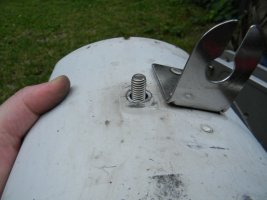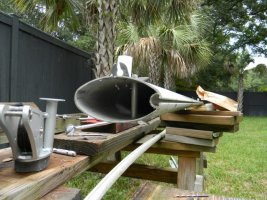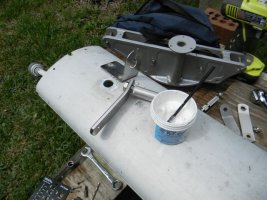tenders
Innocent Bystander
So I've taken my deck-stepped mast down for the first time in ten years to repaint it, and to address some flexing in the deck underneath the mast step.
When I last painted the mast in 1995, I installed aluminum tubes around each of the through-bolts that pins the two sets of spreaders to the mast. The thinking was that these would prevent excessive compression from the nut from collapsing the mast section. These tubes are not particularly thick - I think I got them from a machine shop.
Having removed these through-bolts now after 19 years -- the mast did not fall down over that time, though it was taken down twice for the winter -- my impression is that the "compression tubes" were not necessary nor would they have been effective had they been called upon to do anything.
* They're corroded to the stainless bolts, preventing any inspection of the (anaerobic) environment inside.
* They're thin, certainly providing no significant strength to the fastener or providing real resistance to overtightening.
* They're not perfectly sized to the width of the mast - they're a few 64ths shorter, though perhaps that was my error.
* Finally, with nearly 20 years of internet content having been built up since 1995, there seems to be very spotty mention of these things being used with Ericsons or other boats. I did find some mention of people using Garolite tubes and some Rube Goldberg methods of getting them up the mast, but generally compression tubes seem like the exception rather than the rule.
So, do I need to replace them when I replace the through-bolts? The through-bolts, by the way, are as pristine as the day they were installed, save for the compression sleeves corroded around them!
When I last painted the mast in 1995, I installed aluminum tubes around each of the through-bolts that pins the two sets of spreaders to the mast. The thinking was that these would prevent excessive compression from the nut from collapsing the mast section. These tubes are not particularly thick - I think I got them from a machine shop.
Having removed these through-bolts now after 19 years -- the mast did not fall down over that time, though it was taken down twice for the winter -- my impression is that the "compression tubes" were not necessary nor would they have been effective had they been called upon to do anything.
* They're corroded to the stainless bolts, preventing any inspection of the (anaerobic) environment inside.
* They're thin, certainly providing no significant strength to the fastener or providing real resistance to overtightening.
* They're not perfectly sized to the width of the mast - they're a few 64ths shorter, though perhaps that was my error.
* Finally, with nearly 20 years of internet content having been built up since 1995, there seems to be very spotty mention of these things being used with Ericsons or other boats. I did find some mention of people using Garolite tubes and some Rube Goldberg methods of getting them up the mast, but generally compression tubes seem like the exception rather than the rule.
So, do I need to replace them when I replace the through-bolts? The through-bolts, by the way, are as pristine as the day they were installed, save for the compression sleeves corroded around them!





